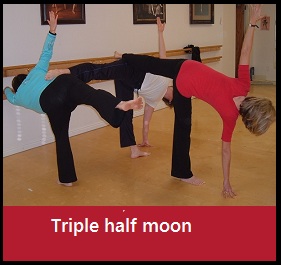We have seen this fish before in our study of the myths behind the yoga postures. Its the same fish that pulled the ark and saved the few sages from the great deluge.
![]()
One of the reasons this posture is called fish pose is that when you bring this posture to the body when you are in water, you will float in safely on the water. The lungs are filled with air and front ribs lifted and expanded. This keeps the body floating upright and could be maintained for a long time if needed.

Now, back to the story: Matsya in Hindu mythology is the first avatar of Vishnu, the protector. A king and devotee of Vishnu, Satyavrata who later was known as Manu (first man) was washing his hands in a river when a little fish swam into his hands and pleaded with him to save its life. He put it in a jar, which it soon outgrew. He then moved it to an increasingly larger container but every few days the fish would outgrow its home. Even the river was not large enough. Finally the fish was transferred to the ocean. The fish then revealed himself to be Vishnu and told Satyavrata that a deluge would occur within seven days that would destroy all life. Therefore, Satyavrata was instructed to take all medicinal herbs, all the varieties of seeds, and seven great sages along with the serpent Vasuki and other animals onto a large boat.
The serpent Vasuki was attached to a horn the great fish had grown on his forehead and Matsya pulled the boat to Mt Himavan where mankind began again. Lord Matsya is generally represented as a four-armed figure with the upper torso of a man and the lower of a fish.
A quote from one of India’s most popular mythologist: Dr Devdutt Pattanaik
“Every time dharma or truth is threatened Vishnu mounts his eagle, the mighty Garuda, and comes to earth ready to do battle. The descents of Vishnu to earth are his avatars or incarnations. The form in each descent is different because the demands of the world each time are different. The different avatars thus reinforce the idea that rules and regulations that maintain order are not static by nature. They are forged when the demands of desire clash with the quest for order.
As man’s understanding of the world changes, desires change and so do concepts of order. Rules have to therefore constantly adapt themselves. Social stability must not be compromised, yet new ideas must be respected. Vishnu’s descents are not just about reestablishing order. It is also about redefining them.”
Some see the ten incarnations of Lord Vishnu as a journey of the advancement of earthly creation and human civilization. Here is a list of the 10 avatars of Vishnu along with the metaphor of creation or the evolution of man’s consciousness.
1. Matsya (the fish) Life developing in the oceans
2. Koorma (the tortoise) A creature that can live both in water and land
3. Varaha (the boar) a wild beast
4. Narasimha (the human-lion) now moving civilization from beast to human form
5. Vamana (the dwarf)a transition to fully human and yet not yet very intelligent
6. Parasurama (the angry man, Rama with an axe) A forest dweller with the axe as his weapon.
7. Lord Rama (the perfect man, king of Ayodha) Civilized man that represents development of small communities or villages. He represents the king that protects his village and people with his superior ability with a bow and arrow
8. Lord Krishna (the divine statesman) He is associated with cows and thus representing the domestication of animals and the development of a wider economy. Krishna also was the one who tried to prevent a great civil war
9. Balarama (elder brother of Krishna) Tool is the plow representing man moving from hunting and gathering to cultivation and agriculture
Some lists show Buddha as #9 avatar and that brings the human civilization into the idea of man’s increasing understanding of his own spiritual nature.
10. Kalki (the mighty warrior) This avatar has yet to be told in the mythology but it is meant to be a mighty warrior that will destroy the world.
References for stories and picture:
hindu blog
Wiki
children’s stories
about.com



